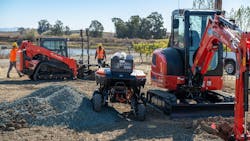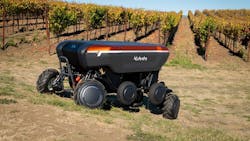Kubota Integrates Autonomy, Robotics
Artificial Intelligence (AI), machine control, and autonomy are fortifying machine intelligence for the future. Concept robotic machines—such as Kubota’s KATR, a compact, four-wheeled robot for off-road agricultural and construction applications—are a more recent introduction, but may be coming down the pike sooner rather than later.
Brett McMickell, CTO at Kubota North America, says the company’s current outlook on its advanced construction technologies centers around three key pillars: advanced sensors, artificial intelligence (AI), and autonomy.
“What we’re looking at is how do we connect that [technology] to provide a real solution,” McMickell says. “Some companies are doing sensors, others are exploring AI and autonomy, but we’re focused on bringing it all together.”
Kubota’s core goal is to improve work processes in agriculture, construction, and residential spaces by leveraging technology to reduce complexity, enhance safety, and improve operational efficiency, according to McMickell. One way the company seeks to achieve this ideal role of technology is with its KATR concept. The KATR is a versatile platform that supports various applications, from robotic arms for agricultural tasks like pruning to autonomous material transport on construction sites. McMickell says the KATR can be adapted with various modules, sensors, and technologies to serve diverse needs.
More coverage from CES 2025
Endeavor Business Media has several brand reporting from CES 2025. Here is a selection.
- John Deere autonomous articulated dump truck.
- Bosch: ‘We’re still heavily involved in hydrogen’ as trucking’s future fuel, from Fleet Owner
- Technology and announcements you probably won't see on the trade-show floor, from Electronic Design.
- Latest in smart lock technology, from Security InfoWatch
- BenjiLock Outdoor Fingerprint Padlock, from Security InfoWatch
Kubota’s use of AI and sensors in agriculture is an example of how the technology might expand to the construction sector. In a test, the KATR was deployed in an orchard, equipped with sensors, and scanned for signs of pests or disease. Once identified, AI generated actionable recommendations for the grower, such as applying a targeted pesticide. An autonomous sprayer can then carry out the task, effectively closing the loop between detection, analysis, and action.
“You’re seeing that kind of seamless integration help improve overall processes,” McMickell says.
As Kubota plans to discuss at CES 2025, it plans to introduce machines such as the electric X38-4E excavator to North America, which McMickell says will offer a quieter, more efficient design. The machine can be used indoors due to its smaller size and electric powertrain. McMickell also touches on the rising affordability of advanced technology, like millimeter-grade control, which is now available for smaller machines such as the company’s SVL compact track loader series.
“If you combine our autonomy with our millimeter grading, rather than having a large motor grader, you can now use multiple SVLs working together to achieve the same task,” McMickell says.
McMickell says its integration of autonomous systems is also meant to address the labor challenges faced in the construction industry. Although fully autonomous construction sites remain unexplored, Kubota has embraced assistive technologies, allowing less-skilled operators to work with the precision and confidence of professionals.
The SVL series, for example, features grading controls that assist operators in maintaining millimeter-level accuracy. This accessibility is something McMickell sees as potential of the technology.
“That’s the direction that we’re going toward,” he says. “With the sensing technologies coming down, there are certain tasks that make sense to automate. At the same time, finding ways to have an operator in there who’s skilled at what they’re doing seems to be a lot more powerful and will still address a large portion of that labor shortage.”
Kubota also focuses on safety with it’s autonomous approach. To mitigate risks, the company is integrating obstacle detection sensors into its machinery, which help prevent accidents on construction sites. By combining these safety features with autonomous technology, Kubota aims to make heavy machinery easier to operate and more accessible to a wider range of workers, according to McMickell.
Although the three pillars of Kubota’s advanced construction technologies have the potential to address problems facing fleet managers, the cost associated with implementing them can be an issue itself. McMickell emphasizes Kubota’s goal to develop scalable solutions that enable fleets to grow their technology solutions without facing prohibitive costs.
“We want to provide customers with choices,” he says. “Particularly our sensor technology and its scalability allow them to scale out their operations without having to jump all in.”
About the Author
Harlee Hewitt
Harlee is a former associate editor for Construction Equipment.

